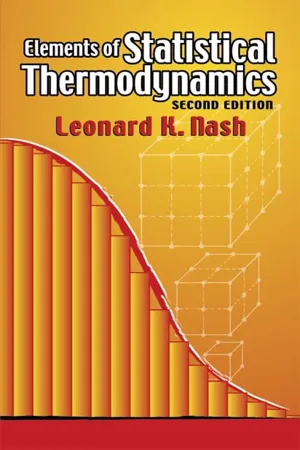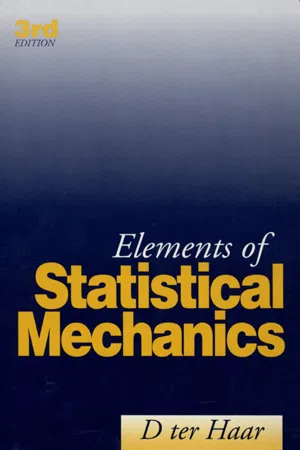Technology & Engineering
Partition Function
The partition function in engineering refers to a mathematical function used to describe the distribution of energy levels in a physical system. It is commonly used in statistical mechanics to calculate the thermodynamic properties of a system, such as the internal energy and entropy. By considering the different ways energy can be distributed among the system's particles, the partition function provides valuable insights into the system's behavior.
Written by Perlego with AI-assistance
Related key terms
Related key terms
1 of 4
Related key terms
1 of 3
4 Key excerpts on "Partition Function"
- eBook - ePub
Elements of Statistical Thermodynamics
Second Edition
- Leonard K. Nash(Author)
- 2012(Publication Date)
- Dover Publications(Publisher)
However it is computed, the magnitude of the Partition Function z reflects the net accessibility of the various quantum states at the given temperature. And precisely because it does so measure the “spread,” the Partition Function constitutes the essential link between the molecular parameters of the unit and the macroscopic parameters of an assembly of such units. That is, the Partition Function offers us the possibility of calculating all the thermodynamic parameters of a macroscopic assembly from spectroscopic measurements that establish the energies of the quantum states characteristic of the units constituting that assembly. We can capitalize on this important possibility only after we have mastered in detail the proper formulation and evaluation of Partition Functions. But before embarking on the somewhat tedious analysis required, we may do well to look at an example that highlights the importance of the Partition Function. This example demonstrates, for one peculiarly simple case, that knowledge of Partition Functions represents power to compute the equilibrium constant of an otherwise uncharacterized chemical reaction.Chemical equilibrium and the Partition Function. Gas-phase isomerization reactions (e.g., the interconversion of butane and isobutane, or of cis and trans butene-2) are important molecular equilibria of the type:A ( ) = B ( ).Figure 12 offers a highly schematic display of the possible quantum levels of A and B—each set comprising every possible combination of the translational, rotational, vibrational, and electronic quantum states of the respective pure species in its standard state. Each energy ∈Ai or ∈Bi is measured in the usual way from the respective ground-state energy ∈AO or ∈BO . As indicated, the two ground states will ordinarily differ in energy by some quantity we symbolize as . As usual, the superscript 0 refers to the standard-state condition, while the subscript 0 denote the temperature of 0°K at which all units must fall in their respective ground states. Representing the quantity of energy required to convert one molecule of A in its ground state into one molecule of B in its ground state, thus expresses the energy change when one molecule of A undergoes the above reaction at 0°K. Concerned as we now are with an equilibrium involving both A and B, we must of course take care to reduce all our energy measurements to a single self-consistent basis. This we can easily do. Setting our reference zero of energy to coincide with the ground state of A, i.e., taking ∈A0 ≡ 0, we need only add the quantity to each of the B-group energies. That is, for the energy of the ith quantum state of B we will write (∈Bi + - Biman Bagchi(Author)
- 2018(Publication Date)
- CRC Press(Publisher)
PV . Thus, the isothermal-isobaric Partition Function can be expressed in terms of the canonical Partition Function by the Laplace transform:Ξ ( N , P , T ) =5.791V 0∫ 0 ∞d V exp ( − β P V ) Q ( N , V , T )5.79Where V 0 is a constant that has units of volume. Thus,The Gibbs free energy is related to the Partition Function byΞ ( N , P , T ) =5.801V 0N !h3 N∫ 0 ∞d V∫d X exp ( − β ( ∏ ( X ) + P V ) )5.80Thus, Gibbs free energy is the thermodynamic potential of the isothermal-isobaric ensemble. This is, of course, anticipated from thermodynamics, and has been mentioned earlier.G = −5.81k BT ln Ξ ( N , P , T )5.815.9 Physical Interpretation of Partition Function (PF) in Different EnsemblesWe have already discussed some aspects, but let us reiterate some points. First, a Partition Function provides the weight of the system, under the chosen conditions. This statement translates into certain extremely useful extremum conditions that we employ almost every day in our study of complex systems. Note that the thermodynamic potential of each Partition Function is given by the logarithm of the same. For example,S =5.82k Bln Ω5.82A = −5.83k BT ln Q5.83For a given thermodynamic state the Partition Function is maximum at equilibrium. Let us elaborate on this often quoted statement, to gain some physical insight.5.84= ln ΞP Vk BT5.84Consider a physical quantity, ξ . This can be a function other than the state functions used to specify the thermodynamic state of a system. For example, this can be a reaction coordinate in a chemical reaction, order parameter in a phase transition. We consider the extremum principle in the context of this parameter ξ . The PF is maximum at that value of ξ where the system spends maximum amount of time. This is obvious in a microcanonical ensemble, where the PF measures the number of microscopic states. In the canonical ensemble the time spent in each energy level is weighted by the Boltzmann factor. In the grand canonical ensemble a further weightage is coming from fugacity to take into account the weightage of the state with given N- eBook - ePub
Phase Modeling Tools
Applications to Gases
- Michel Soustelle(Author)
- 2015(Publication Date)
- Wiley-ISTE(Publisher)
6 Molecular Partition Functions6.1. Definition of the molecular Partition Function
The molecular Partition Function is defined, for an ensemble composed of many particles of molecular dimensions each with the energy εi , by the equation:[6.1]6.2. Decomposition of the molecular Partition Function into partial Partition Functions
The molecular Partition Function for a system includes terms that relate to different forms of energy: nuclear, electronic, vibrational energy of molecules, their rotational energy, their translational energy and interaction energies between different molecules.To simplify this, we know that different forms of energy, for a molecule, are independent (however, there are exceptions, e.g. the interdependence of vibrational and rotational energies of a molecule). Under these conditions, we can write the total energy of a molecule as the sum of different contributions by different forms of energy: nuclear εn, electronic εe, vibrational εv, rotational εr , translational εt and interaction εI, i.e.:[6.2]The Partition Function becomes:[6.3]This shows the partial Partition Functions related to the different forms of energy:[6.4]The overall Partition Function takes the form of the product of the partial Partition Functions:[6.5]Calculating partial Partition Functions requires that the number of degrees of freedom for each type of molecule movement is known.If a molecule is composed of N atoms, it has a total of 3N - eBook - ePub
- D. ter Haar(Author)
- 1995(Publication Date)
- Butterworth-Heinemann(Publisher)
CHAPTER 3THE Partition Function
3.1 The Partition Function
So far we have used classical mechanics to describe the systems in which we were interested. We know, however, that in many instances classical mechanics is inadequate to describe the behaviour of physical systems, and that only a quantum-mechanical treatment can give correct results. We should thus build statistical mechanics upon a quantum-mechanical basis and afterwards show that, indeed, the classical formulæ that we derived in the preceding chapters are limiting cases of the quantum-mechanical formulæ. We shall see in the next chapter that the statistical methods used are the same for all cases and that the term “quantum statistics” is thus a misnomer.We remind ourselves that there are two aspects in which quantum mechanics differs from classical mechanics: “diffraction” effects and “symmetry” effects. The first arise because of the wave nature of matter; they lead to the Schrödinger wave equation and thus to the existence of energy levels for the systems considered. The second occur because the wavefunction of a system of identical particles must be totally symmetric or totally antisymmetric, if we are dealing with bosons or fermions. In the present chapter we shall be concerned with the diffraction effects only, postponing until the next chapter the discussion of symmetry effects as well as a brief discussion of to what particles these consideration apply.Let us consider a system of particles, each of which has a discrete energy spectrum. Let the energy levels beεn, all of which we shall for the moment assume to be non-degenerate.1 We can now ask the question: “How many particles will be in each of the various levels, if we know that the total energy of the system consisting of N particles is E? ” This problem is similar to the one treated in § 1.7 . The cellsZiintroduced there correspond now to the discrete energy levels. Assuming that the a priori probability for a particle to be in a particular energy level is the same for all levels, we may put allZiequal to one another, and we find for the probability W that there are N 1 particles in the energy level ε1 ,N2in the level ε2 , and so on (compare Eq.(1.701)
Index pages curate the most relevant extracts from our library of academic textbooks. They’ve been created using an in-house natural language model (NLM), each adding context and meaning to key research topics.
Explore more topic indexes
Explore more topic indexes
1 of 6
Explore more topic indexes
1 of 4



